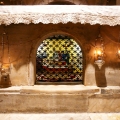Tradition, as collected by Pliny the Elder in his Natural History, says that Jaffa (or Joppa) was founded by one of Noah’s sons after the flood. Indeed, Jaffa is so ancient that it was already there when the Israelites arrived. Even more so, Pharaoh Thutmose III (Egypt’s greatest warrior pharaoh ever) had decided to conquer it by sending cunning, hiding soldiers in gift baskets.
Jaffa means beautiful in Hebrew and Arabic –hence, the most beautiful harbor in the world. Palestinians still call it the “bride of the sea.” Scholars of Greek mythology claim it was here where the beautiful Andromeda was chained to a rock, naked, ready to be sacrificed to the Hydra –Perseus, the story goes, had other plans.
Uninterruptedly inhabited for more than 7000 years, Jaffa is today a municipality of Tel Aviv. It has lost its military and strategic importance, but not an inch of its beauty. As artists have chosen it as their neighborhood, it is bursting with galleries, exhibitions, and all sorts of cultural centers and events. A unique combination of the ancient and the contemporary, its modern urban colors contrast with the sober white stone of antique constructions and the bright blue sea.
Jaffa is the port, tradition claims, where the materials ordered by King Solomon to build his Temple arrived to. This is also the harbor from which the prophet Jonah sailed away (“He went down to Joppa and found a ship going to Tarshish,” the book of Jonah reads) only to end up in the stomach of a whale. A nice bronze statue on the harbor’s promenade reminds the visitor of this biblical passage.
Jaffa’s Christian history is also significant. It is the hometown of Simon the Tanner –a character mentioned in the Book of Acts not one, but three times. The text claims he had a house in Jaffa, where Peter stayed during his missionary trips. It was on the roof of Simon’s house where Peter had a vision of “something like a large sheet being let down to earth by its four corners. It contained all kinds of four-footed animals, as well as reptiles and birds.” The text goes:
Then a voice told him, “Get up, Peter. Kill and eat.”
“Surely not, Lord!” Peter replied. “I have never eaten anything impure or unclean.”
The voice spoke to him a second time, “Do not call anything impure that God has made clean.”
This happened three times, and immediately the sheet was taken back to heaven.
This, and other events that Christian tradition claims happened at Simon’s house, have been interpreted as leading the early followers of Jesus to open up their ranks also to the Gentiles –after starting as a distinctively Jewish messianic movement.
The port of Jaffa is also the stage of plenty of noted round trips. Take, for example, Saint James’ disciples. Tradition holds they sailed from Jaffa, carrying the Apostle’s body with them, right after he was executed by King Herod, for his final burial in Santiago de Compostela. For centuries, Jaffa was also the port of arrival for all European Christian pilgrims traveling to Jerusalem, as they reached the last stage of the pilgrimage to the Holy City –the noted “Way of Silence.”
In the 20th century Jaffa literally became a safe harbor for European Jews fleeing the Russian pogroms and the Nazi persecution. Persian pilgrims traveling to Mecca also crossed through Jaffa –as attested by a photograph taken in the early 20th century.
Nowadays, Jaffa stands as an ancient symbol of cultural, religious, human encounter throughout the centuries –despite all difficulties.
This post is also available in: Español





